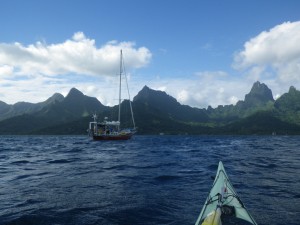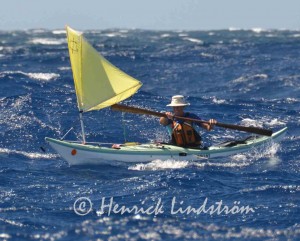The crossing from Tahiti to Moorea gives Ginni Callahan the perfect opportunity to get off the sailboat Misty and into her kayak. Now, if only the weather will cooperate.
This is how most nautical disaster stories begin – it wasn’t quite the weather we wanted, but we had to go anyway.
When we sail, I often watch the sea and imagine paddling in it. However, 2,500-nautical-mile crossings are more than I want to tackle in a kayak. The Tahiti to Moorea crossing, at 17 nm, was finally within reach.
In an area of SE trade winds, it was an odd forecast: winds ENE up to 20 knots. Swell east, turning south and building to three meters. The following days promised even bigger swell and more wind, plus we’d checked out from Tahiti and needed to leave by Sunday. The forecast really wasn’t THAT bad, we reasoned, and the day dawned calm.
I started out at 9:30, and Henrick was to follow an hour later in Misty. If I kept a 3.5 knot pace with breaks, and if he traveled at 4.5 to five knots, then I reasoned he should catch me about three hours into the crossing, which should take me about five hours and him around four hours. We could adjust to each other for the last hour, or pull the kayak on board.
I carried a VHF radio and a GPS in order to monitor my speed and update Henrick with my coordinates so he could find me if we didn’t see each other. I didn’t expect him to see me, but I should see his tall sail. However, it’s a big sea out there.
Leaving from the western side of Tahiti, we’d be sheltered for a little while. But this wasn’t just shelter; there was NO wind. A long four-foot south swell crossed a shorter, steeper three-foot NE swell, making for gentle, non-rhythmic lumps.
When I called Henrick on the radio at 10:30 to tell him the conditions and my progress, it was a pleasant morning leisure paddle, full of daydreams and watching for seabirds and occasional motorboats. When I called him the next hour, he could barely hear me. He’d gotten a late start and I a five-mile lead. There was marginally enough wind to put up my Flat Earth Kayak Sail. The south wind was not even creating whitecaps. It soon turned west in my face, light enough to just be refreshing.
I took down the sail and entertained myself by surfing the NE swell, which had gotten steeper – a warning sign, but still no wind line in sight. Speaking of sight, there wasn’t much but water and sky in view most of the time because the combined swells were bigger out of the lee of Tahiti and obscured all but the tops of the mountainous islands. I heard three motor boats coming up behind me long before I could see them. I remember thinking that, while these big seas were fun now, a strong wind could raise the excitement factor exponentially, perhaps too much.
Suddenly my mind talked reason to me. “Bailing out of your kayak will make a bigger mess. Don’t exit, just roll up.”
As long as the sea conditions allowed, I ate the food and drank from the water bottle stashed in my day hatch, leaving the snacks and hydrator in my PFD for when I could no longer access the hatch without risk of flooding it or capsizing. I had just climbed back into my kayak from a refreshing dip when the sea got splashy. Little chop. I looked up from getting myself situated, and there wasn’t just a wind line to the NE, there was a mean whitecap texture to it, and it was approaching fast. Just enough time to seal myself up and hoist the sail. Now I was cruising – five to six knots. The wind built fast, achieved all of the forecasted 20 knots in a belated rush, and soon I was catching uninitiated surf rides of nine knots. Henrick wouldn’t catch me at this rate.
The third time we talked by radio, I was bracing with one hand and keying the radio with the other when I could, still flying along. New plan: I would continue ahead and we’d talk at 1 p.m. I could already see the streaming spindrift from the giant breakers on the Moorea reef about a mile ahead (when I was on top of the swell enough to see anything).
Ten minutes later I almost surfed into a motorboat I hadn’t seen over the swells. Three Polynesian fishermen wore surprised looks as I zoomed by under my little kayak sail and waved. Whenever I rose to the top of the swells, I’d check the line of reef break to my right and search to the left for Henrick’s sail. I thought I saw a thin vertical line of white. How I wanted that to be Henrick’s sail! Flying along was fun, but I wanted the company, and the security. And photos!
I turned upwind and dropped the sail, ate a bite of snack and had a sip of water. It’s essential to keep the engine fueled before it runs low in these conditions, this far out. From the near corner of the Moorea reef, we had six nautical miles to go to the pass, and then probably another half-mile into the lagoon to anchor. With this wind direction, the final push would be upwind, after potentially two more hours of paddling.
I felt great. Energized by surf. I thought if I can keep that pace, I could match Henrick, even have to slow down for him sometimes. I could paddle back to meet him and enjoy the rough stuff together before we rounded the reef and maybe lost the surfable waves.
I paddled back towards the fishermen, which was also in the direction of Tahiti and where I thought I saw Henrick. Io ora na, I greeted them in Tahitian. They spoke no English, so I mimed to ask if they could see a bateaux in the direction of Tahiti. Three necks craned from a higher vantage point than I had, and one man cried out and pointed. They agreed. Bateaux. French is the trade language of these parts. Thankfully, “boat” is among my limited vocabulary. Maitai roa! I exclaimed. Good! And thanked them in Tahitian. They smiled and waved, looking a little concerned.
1 p.m. and the radio crackled. “I see you!” I replied. Over one swell, I actually saw the red hull below the sail, relieved to know that I was looking at the right sailboat.
“I don’t see you” came the reply. No surprise there, since I was a lot smaller. I looked at my compass and pointed my kayak at the boat. 90 degrees
“I’m 270 degrees from you, less than half a mile out.” I said.
I snapped photos of him coming closer, then turned and surfed along, taking photos with one hand and bracing with the other. He snapped photos of me too. When even one swell came between us, I couldn’t see him at all, just the sail. Directional control for both of us was challenging enough not to want to get closer. Misty’s mast swung in all directions in the crazy swell. Waves would pivot the boat and the wind-steering would slowly bring it back. The kayak sometimes took off in a direction not completely of my choosing, and once at speed, capsizing was my only option to stop quickly.
Now I had a speed to match. Henrick still had full sail up on Misty and was doing almost seven knots. The wind dropped slightly and I had to paddle full out between surf rides, and sometimes during the surf. After a half an hour or so of the intensity, he pulled ahead and I could feel my energy waning. I took up my radio to call him and ask if he could reef the sail or turn upwind to let me gain a little on him. In the moment of releasing the paddle with one hand and glancing down, a wave knocked me over. Under water. Tired, not wanting to get left behind. Wit’s end. Time to exit. I reached for the loop on my skirt.
I did what?! Stop the music!
Suddenly my mind turned back on and talked reason to me. “Bailing out of your kayak will make a bigger mess. Don’t exit, just roll up. You have plenty of air. Be calm and do it.” So I did.
The sail flopped to the side, the radio dangled from its tether, Misty pulled ahead. I gathered the sail and bungeed it, then picked up the radio and heard it crackling. Henrick asked if I was OK.
“I’m fine,” I panted, still out of breath from the long sprint.
“Do you want me to wait?”
“Yes, please!”
From here my world got calmer, but Henrick’s went a little wonky. Motor on, turn upwind to reef, crazy lumpy sea. He took two reefs in the sail and went back on course. Somewhat protected by Moorea’s coral reef, we could travel near enough to shout to each other over the engine, which he left running so he could help me if needed. At one point, the preventer line from the mainsail flopped into the water and caught in the propeller.
We paused so I could clear the line from Misty’s propeller, a good excuse for another swim and a little break. For Misty, a critical repair before she could go by engine again.

So it wasn’t really a disaster story, just moments of excitement. Both nearing our limits of skill and coping, both pulling through in the end.
We cruised along in the slowly calming sea and dropping wind. I could keep up, even maneuver about and take photos of Misty with the verdant spires of Moorea in the background. Eventually, the wind died altogether and my sail flapped. I took it down. Henrick motored along at four knots for the last mile and I focused on paddling technique and breathing. Mantra: one more mile.
We entered the pass together, snapping photos of each other in front of perfect, peeling Polynesian waves.


